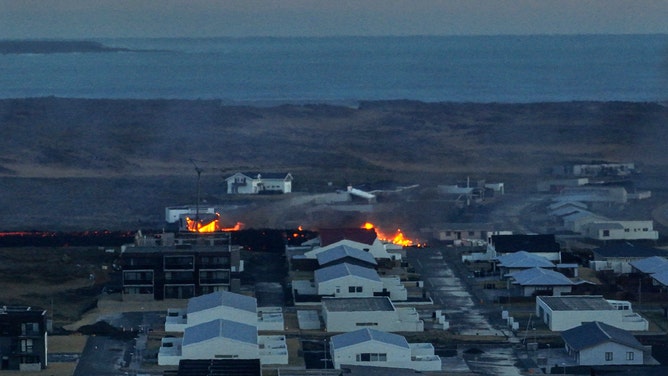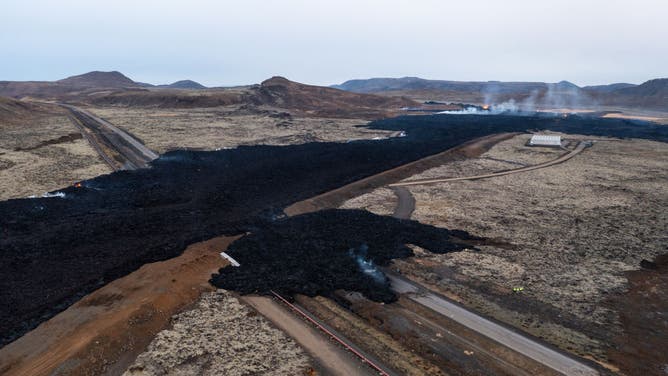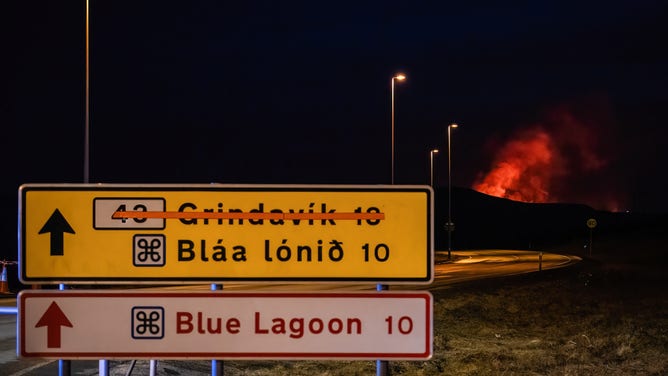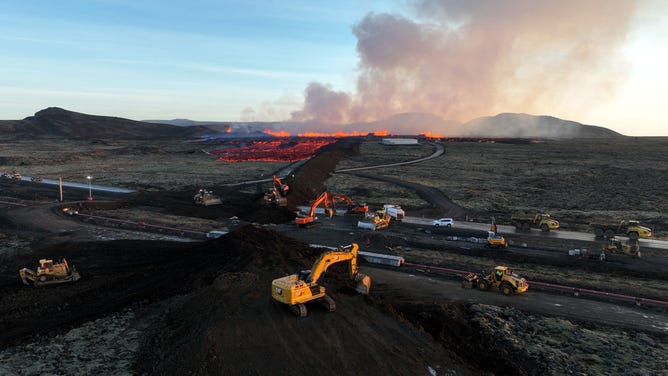Aerial video from Iceland shows aftermath of homes destroyed by lava
Residents of Grindavik are wondering if they'll ever be able to return home after another volcanic eruption, and scientists say they believe more could be coming.
Aerial aftermath: Video of Iceland homes destroyed by lava
The Coast Guard flew over Grindavik, Iceland on Monday after the lava from the erupting volcano cooled to see the three homes that were destroyed.
GRINDAVIK, Iceland – The lava is cooling, and the eruption appears to have stopped in Iceland after the most recent volcanic eruption in the town of Grindavik that destroyed three homes.
One man said he watched the dream home he was almost done building burn on live TV. He planned on moving in before Christmas, but the November evacuation and the December eruption of the volcano pushed plans back.
ICELAND VOLCANO: NEW ERUPTION SENDS LAVA INTO GRINDAVIK, DESTROYS HOMES

Lava explosions and billowing smoke are seen near residential buildings in the southwestern Icelandic town of Grindavik after a volcanic eruption on January 14, 2024.
(HALLDOR KOLBEINS/AFP / Getty Images)
"You sit and watch the news just now showing everything going up in smoke," homeowner Hrannar Jon Emilsson told Reuters. "Then they played a song making me burst out laughing. The song they played was 'I'm Sorry' at the same time I watched my house burn down. This just made me laugh because I did not know how to respond to this: Smile, laugh or cry, I really don't know."
HOMES BURNED IN POOL OF GLOWING LAVA IN ICELAND
Drone video of Iceland volcano erupting
A new fissure opened Sunday near Grindavik, Iceland on the wrong side of the lava barrier. Three homes burned as the lava pooled around them. Drone video shows the molten rock still flowing towards the town in the first fissure as well.
A long time before residents can return
Another resident of Grindavik considered him lucky, though. She said at a public meeting that was recorded for social media that the most difficult day for her was when she woke up and saw that her home had not burned. She said if it did, she could make a clean start somewhere else.
Homes like hers, that are still standing, didn’t all fare well, though. The temblors damaged foundations, and moving magma under the town destroyed infrastructure. The whole town uses geothermal-generated power. Cracks in roads are widening, and some thoroughfares are covered with lava.

A drone photo of lava that crossed the highway.
(NurPhoto / Getty Images)
"Still they're without power, hot and cold water, and all the houses are heated with water, warm water, so all the houses are under severe damages from the cold because they have now cold water in all the pipes which can burst due to frost, so it is not a good situation," Haraldur Haraldsson of the Sudurnes Search and Rescue Team, said. "They will not be returning for the next few weeks at least. It has to be a livable situation there and without electricity, hot and cold water, it's not possible for them to turn back."
Others were less optimistic about the residents of Grindavik returning in weeks.
WATCH A VOLCANO MAKE ITS OWN WEATHER

A photo showing the eruption of a volcano outside the town of Grindavik in Iceland on Sunday, Jan. 14, 2024.
(Iceland Department of Civil Protection and Emergency Management/Facebook)
Magma reservoir filling up again under town
Scientists said that GPS shows magma filling up the reservoir that was emptied by the eruption. The Icelandic Met Office warned that new fissures and cracks could appear at any time, especially in the next few days. The office wrote: "It is premature to declare that the eruption is over."
The head of the Nordic Volcanological Center at the University of Iceland said that she and her colleagues are waiting for the next event. The only certainty is that the area will have more volcanic activity.
"This is a very hazardous area, and it has a potential to be repeating events in the future as well," Volcanologist Rikke Pedersen told Reuters. "So even though this particular volcanic eruption is over, it doesn't mean that all is good for Grindavik."
WHAT MAKES ‘PELE’S HAIR' DURING A VOLCANIC ERUPTION?

Access to Grindavik is closed.
(Raul Moreno/SOPA Images/LightRocket / Getty Images)
Recent history
Magma pushed towards the surface of the Reykjanes Peninsula, forcing the entire 4,000-person town to evacuate in November. After a brief eruption, about 200 townspeople returned, only to be evacuated again around 3 a.m. Sunday when a new fissure opened. That fissure was on the other side of the lava barrier, though.
Around noon, another fissure opened within the town's protective barrier. Lava flowed into the town.

Aerial view taken on January 14, 2024 shows emergency personnel using diggers to build a protective wall trying to prevent flowing lava to reach the center of the southwestern Icelandic town of Grindavik after a volcaninc eruption. S
(HALLDOR KOLBEINS/AFP)
The Reykjanes Peninsula has seen four eruptions in the past three years, and five since 2021. Before 2021, volcanoes only erupted in Iceland an average of every five years. The president said that lava hadn't flowed into Iceland homes in 51 years, in a press conference.

